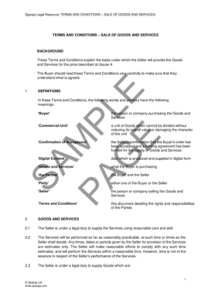 In this latest blog in our ecommerce series, we answer the question ‘Can terms and conditions be changed?’ Since it’s crucial to be clear and upfront with your customers, you shouldn’t change your terms and conditions after you’ve already made a sale. It’s also likely to be unfair to include certain terms in your T&Cs to consumers, such as allowing you to change prices based on cost increases, or to change delivery terms at any time.
In this latest blog in our ecommerce series, we answer the question ‘Can terms and conditions be changed?’ Since it’s crucial to be clear and upfront with your customers, you shouldn’t change your terms and conditions after you’ve already made a sale. It’s also likely to be unfair to include certain terms in your T&Cs to consumers, such as allowing you to change prices based on cost increases, or to change delivery terms at any time.
Although terms and conditions of sale are not strictly a legal requirement (as we discuss in our latest blog in this series), they are strongly recommended and are vital for running a successful ecommerce business. Ensuring that your terms and conditions are clear and legally compliant helps you to maintain good customer relationships and reduce the risk of future disputes, complaints and/or liabilities against your business.
This blog discusses whether and when terms and conditions can be changed, and how to provide your terms and conditions to ensure customers have all the relevant information when making a purchase from you.
Whether terms and conditions can be changed
Changing terms and conditions after a sale is made
It’s important that your terms and conditions of sale are clear, and you and your customer both agree to them, before an online sale is concluded. Once you have agreed an online sale with a customer, you should not change your terms and conditions of sale without that customer’s consent. Otherwise, you risk your change being unfair and unenforceable.
If you use our template Terms and conditions – Sale of goods, Terms and conditions – Services, or Terms and conditions – Sale of goods and services, these terms specify that you must get your customer’s signed consent in writing to any changes you make.
If you use your own bespoke terms and conditions, you should make sure your terms are not unfair to customers, and get their consent in writing to any additional changes you make to the terms after you have completed a sale. For example, it is likely to be unfair to include terms to the following effect in a contract with a consumer:
- that prices of goods may be raised if stock prices or other costs increase before delivery;
- that delivery dates and costs may be changed at any time; or
- that the business can change its terms at any time as it deems necessary.
It’s a good idea to get legal advice if you’re creating your own bespoke terms, to ensure you cover all the necessary information. You can access a specialist lawyer in a few simple steps using our Ask a Lawyer service.
See this blog for guidance on how to write your terms and conditions of sale.
Changing terms and conditions before a sale is made
You can change your standard terms and conditions of sale at any time, and the new terms will apply to any future sales made after the date you made the change. However, as set out above, you must honour the existing terms and conditions that were in place when any given sale was made.
You should ensure that your terms and conditions of sale on your website include the date they were last updated, to ensure transparency, and notify existing customers that your terms and conditions have changed (eg by email). Advice on changing terms and conditions of an ongoing service (eg a subscription or software programme) is outside the scope of this service; for further advice you can access a specialist lawyer in a few simple steps using our Ask a Lawyer service.
When and how to provide your T&Cs
You can use our terms and conditions templates whether you sell face to face or at a distance, such as through your website. You can also use them whether you’re selling to consumers or other businesses.
Make sure you provide your T&Cs to potential customers before they agree to use your goods and services. This minimises the risk of disputes in future, because you and your customer have agreed how the goods and services will be provided in advance and you should both be aware of your rights and responsibilities.
You should ensure your terms and conditions are easily accessible for your customers. You can do this by including them on all documents you provide to a potential customer (such as order forms, quotes or catalogues), and on your website.
Once your customer has placed their order for goods or services on your website, you must acknowledge the order as soon as possible in writing or via an email. You also need to provide certain other information to consumers after a sale is concluded, such as a link to your privacy policy, confirmation of how and when the goods will be delivered, service completed or digital content provided, and more. See Other information to include on a sales website for further guidance.
The content in this article is up to date at the date of publishing. The information provided is intended only for information purposes, and is not for the purpose of providing legal advice. Sparqa Legal’s Terms of Use apply.

Marion joined Sparqa Legal as a Senior Legal Editor in 2018. She previously worked as a corporate/commercial lawyer for five years at one of New Zealand’s leading law firms, Kensington Swan (now Dentons Kensington Swan), and as an in-house legal consultant for a UK tech company. Marion regularly writes for Sparqa’s blog, contributing across its commercial, IP and health and safety law content.






